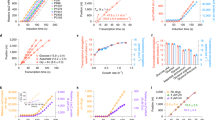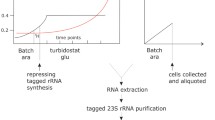Abstract
Elongation factor P (EF-P) is a highly conserved ribosomal initiation factor responsible for stimulating formation of the first peptide bond. Its essentiality has been debated and may differ depending on the organism. Here, we demonstrate that EF-P is dispensable in Escherichia coli and Pseudomonas aeruginosa under laboratory growth conditions. Although knockouts are viable, growth rates are diminished compared with wild-type strains. Despite this cost in fitness, these mutants are not more susceptible to a wide range of antibiotics; including ribosome targeting antibiotics, such as lincomycin, chloramphenicol, and streptomycin, which have been shown previously to disrupt EF-P function in vitro. In Pseudomonas, knockout of efp leads to an upregulation of mexX, a phenotype previously observed with other genetic lesions affecting ribosome function and that can be induced by the treatment with antibiotics affecting protein synthesis.


Similar content being viewed by others
References
Aoki H, Adams SL, Turner MA, Ganoza MC (1997) Molecular characterization of the prokaryotic efp gene product involved in a peptidyltransferase reaction. Biochimie 79(1):7–11. doi:S0300908497876195
Aoki H, Dekany K, Adams SL, Ganoza MC (1997) The gene encoding the elongation factor P protein is essential for viability and is required for protein synthesis. J Biol Chem 272(51):32254–32259
Bailly M, de Crecy-Lagard V (2010) Predicting the pathway involved in post-translational modification of elongation factor P in a subset of bacterial species. Biol Direct 5:3. doi:10.1186/1745-6150-5-3
Balibar CJ, Hollis-Symynkywicz MF, Tao J (2011) Pantethine rescues phosphopantothenoylcysteine synthetase and phosphopantothenoylcysteine decarboxylase deficiency in Escherichia coli but not in Pseudomonas aeruginosa. J Bacteriol 193(13):3304–3312. doi:10.1128/JB.00334-11
Blaha G, Stanley RE, Steitz TA (2009) Formation of the first peptide bond: the structure of EF-P bound to the 70S ribosome. Science 325(5943):966–970. doi:10.1126/science.1175800
Caughlan RE, Sriram S, Daigle DM, Woods AL, Buco J, Peterson RL, Dzink-Fox J, Walker S, Dean CR (2009) Fmt bypass in Pseudomonas aeruginosa causes induction of MexXY efflux pump expression. Antimicrob Agents Chemother 53(12):5015–5021. doi:10.1128/AAC.00253-09
Chaudhuri RR, Allen AG, Owen PJ, Shalom G, Stone K, Harrison M, Burgis TA, Lockyer M, Garcia-Lara J, Foster SJ, Pleasance SJ, Peters SE, Maskell DJ, Charles IG (2009) Comprehensive identification of essential Staphylococcus aureus genes using transposon-mediated differential hybridisation (TMDH). BMC Genomics 10:291. doi:10.1186/1471-2164-10-291
Datsenko KA, Wanner BL (2000) One-step inactivation of chromosomal genes in Escherichia coli K-12 using PCR products. Proc Natl Acad Sci USA 97(12):6640–6645. doi:10.1073/pnas.120163297
de Crecy E, Metzgar D, Allen C, Penicaud M, Lyons B, Hansen CJ, de Crecy-Lagard V (2007) Development of a novel continuous culture device for experimental evolution of bacterial populations. Appl Microbiol Biotechnol 77(2):489–496. doi:10.1007/s00253-007-1168-5
El’Garch F, Jeannot K, Hocquet D, Llanes-Barakat C, Plesiat P (2007) Cumulative effects of several nonenzymatic mechanisms on the resistance of Pseudomonas aeruginosa to aminoglycosides. Antimicrob Agents Chemother 51(3):1016–1021. doi:10.1128/AAC.00704-06
Ganoza MC, Aoki H (2000) Peptide bond synthesis: function of the efp gene product. Biol Chem 381(7):553–559. doi:10.1515/BC.2000.071
Gerdes SY, Scholle MD, Campbell JW, Balazsi G, Ravasz E, Daugherty MD, Somera AL, Kyrpides NC, Anderson I, Gelfand MS, Bhattacharya A, Kapatral V, D’Souza M, Baev MV, Grechkin Y, Mseeh F, Fonstein MY, Overbeek R, Barabasi AL, Oltvai ZN, Osterman AL (2003) Experimental determination and system level analysis of essential genes in Escherichia coli MG1655. J Bacteriol 185(19):5673–5684
Gil R, Silva FJ, Pereto J, Moya A (2004) Determination of the core of a minimal bacterial gene set. Microbiol Mol Biol Rev 68(3):518–537. doi:10.1128/MMBR.68.3.518-537.2004
Glass JI, Assad-Garcia N, Alperovich N, Yooseph S, Lewis MR, Maruf M, Hutchison CA 3rd, Smith HO, Venter JC (2006) Essential genes of a minimal bacterium. Proc Natl Acad Sci USA 103(2):425–430. doi:10.1073/pnas.0510013103
Glick BR, Chladek S, Ganoza MC (1979) Peptide bond formation stimulated by protein synthesis factor EF-P depends on the aminoacyl moiety of the acceptor. Eur J Biochem 97(1):23–28
Glick BR, Ganoza MC (1975) Identification of a soluble protein that stimulates peptide bond synthesis. Proc Natl Acad Sci USA 72(11):4257–4260
Hoang TT, Karkhoff-Schweizer RR, Kutchma AJ, Schweizer HP (1998) A broad-host-range Flp-FRT recombination system for site-specific excision of chromosomally-located DNA sequences: application for isolation of unmarked Pseudomonas aeruginosa mutants. Gene 212(1):77–86 S0378111998001309
Jeannot K, Sobel ML, El Garch F, Poole K, Plesiat P (2005) Induction of the MexXY efflux pump in Pseudomonas aeruginosa is dependent on drug-ribosome interaction. J Bacteriol 187(15):5341–5346. doi:10.1128/JB.187.15.5341-5346.2005
Joyce AR, Reed JL, White A, Edwards R, Osterman A, Baba T, Mori H, Lesely SA, Palsson BO, Agarwalla S (2006) Experimental and computational assessment of conditionally essential genes in Escherichia coli. J Bacteriol 188(23):8259–8271. doi:10.1128/JB.00740-06
Kyrpides NC, Woese CR (1998) Universally conserved translation initiation factors. Proc Natl Acad Sci USA 95(1):224–228
Lau CH, Fraud S, Jones M, Peterson SN, Poole K (2012) Reduced expression of the rplU-rpmA ribosomal protein operon in mexXY-expressing pan-aminoglycoside-resistant mutants of Pseudomonas aeruginosa. Antimicrob Agents Chemother. doi:10.1128/AAC.00846-12
Mushegian AR, Koonin EV (1996) A minimal gene set for cellular life derived by comparison of complete bacterial genomes. Proc Natl Acad Sci USA 93(19):10268–10273
Navarre WW, Zou SB, Roy H, Xie JL, Savchenko A, Singer A, Edvokimova E, Prost LR, Kumar R, Ibba M, Fang FC (2010) PoxA, yjeK, and elongation factor P coordinately modulate virulence and drug resistance in Salmonella enterica. Mol Cell 39(2):209–221. doi:10.1016/j.molcel.2010.06.021
Ohashi Y, Inaoka T, Kasai K, Ito Y, Okamoto S, Satsu H, Tozawa Y, Kawamura F, Ochi K (2003) Expression profiling of translation-associated genes in sporulating Bacillus subtilis and consequence of sporulation by gene inactivation. Biosci Biotechnol Biochem 67(10):2245–2253
Park JH, Johansson HE, Aoki H, Huang BX, Kim HY, Ganoza MC, Park MH (2012) Post-translational modification by beta-lysylation is required for activity of Escherichia coli elongation factor P (EF-P). J Biol Chem 287(4):2579–2590. doi:10.1074/jbc.M111.309633
Peil L, Starosta AL, Virumae K, Atkinson GC, Tenson T, Remme J, Wilson DN (2012) Lys34 of translation elongation factor EF-P is hydroxylated by YfcM. Nat Chem Biol. doi:10.1038/nchembio.1001
Peng WT, Banta LM, Charles TC, Nester EW (2001) The chvH locus of agrobacterium encodes a homologue of an elongation factor involved in protein synthesis. J Bacteriol 183(1):36–45. doi:10.1128/JB.183.1.36-45.2001
Roy H, Zou SB, Bullwinkle TJ, Wolfe BS, Gilreath MS, Forsyth CJ, Navarre WW, Ibba M (2011) The tRNA synthetase paralog PoxA modifies elongation factor-P with (R)-beta-lysine. Nat Chem Biol 7(10):667–669. doi:10.1038/nchembio.632
Sambrook J, Russell DW (2001) Molecular cloning: a laboratory manual. Cold Spring Harbor Laboratory Press, Cold Spring Harbor, New York
Schweizer HD (1993) Small broad-host-range gentamycin resistance gene cassettes for site-specific insertion and deletion mutagenesis. Biotechniques 15(5):831–834
Shimizu Y, Inoue A, Tomari Y, Suzuki T, Yokogawa T, Nishikawa K, Ueda T (2001) Cell-free translation reconstituted with purified components. Nat Biotechnol 19(8):751–755. doi:10.1038/90802
Simon R, Priefer U, Puhler A (1983) A broad host range mobilization system for in vivo genetic engineering: transposon mutagenesis in gram negative bacteria. Nat Biotechnol 1:784–791
Swaney S, McCroskey M, Shinabarger D, Wang Z, Turner BA, Parker CN (2006) Characterization of a high-throughput screening assay for inhibitors of elongation factor p and ribosomal peptidyl transferase activity. J Biomol Screen 11(7):736–742. doi:10.1177/1087057106291634
Westbrock-Wadman S, Sherman DR, Hickey MJ, Coulter SN, Zhu YQ, Warrener P, Nguyen LY, Shawar RM, Folger KR, Stover CK (1999) Characterization of a Pseudomonas aeruginosa efflux pump contributing to aminoglycoside impermeability. Antimicrob Agents Chemother 43(12):2975–2983
Yanagisawa T, Sumida T, Ishii R, Takemoto C, Yokoyama S (2010) A paralog of lysyl-tRNA synthetase aminoacylates a conserved lysine residue in translation elongation factor P. Nat Struct Mol Biol 17(9):1136–1143. doi:10.1038/nsmb.1889
Zimmermann W (1979) Penetration through the gram-negative cell wall: a co-determinant of the efficacy of beta-lactam antibiotics. Int J Clin Pharmacol Biopharm 17(3):131–134
Zou SB, Hersch SJ, Roy H, Wiggers JB, Leung AS, Buranyi S, Xie JL, Dare K, Ibba M, Navarre WW (2012) Loss of elongation factor P disrupts bacterial outer membrane integrity. J Bacteriol 194(2):413–425. doi:10.1128/JB.05864-11
Author information
Authors and Affiliations
Corresponding author
Rights and permissions
About this article
Cite this article
Balibar, C.J., Iwanowicz, D. & Dean, C.R. Elongation Factor P is Dispensable in Escherichia coli and Pseudomonas aeruginosa . Curr Microbiol 67, 293–299 (2013). https://doi.org/10.1007/s00284-013-0363-0
Received:
Accepted:
Published:
Issue Date:
DOI: https://doi.org/10.1007/s00284-013-0363-0




